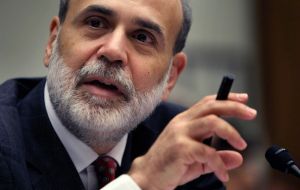MercoPress. South Atlantic News Agency
Fed injects more ‘accommodation’ liquidity to bonds’ market and housing
 Bernanke, “significant downside risks to the economic outlook, including strains in global financial markets”
Bernanke, “significant downside risks to the economic outlook, including strains in global financial markets” With three dissenting members the Federal Reserve announced on Wednesday further efforts to prop the US economy launching an accommodation program to put more downward pressure on long-term interest rates and increase its support for housing.
Warning of “significant” downside economic risks, the US central bank said it would launch a 400 billion dollars program to twist its 2.85 trillion dollars balance sheet more heavily toward longer-term securities by selling short-term government debt to purchase longer-dated Treasuries.
It also said would reinvest proceeds from maturing mortgage and housing agency bonds it holds back into the mortgage market, an acknowledgment of just how weak housing remains.
The FOMC decided to extend the average maturity of its holdings of securities and “intends to purchase, by the end of June 2012, 400 billion of Treasury securities with remaining maturities of 6 years to 30 years and to sell an equal amount of Treasury securities with remaining maturities of 3 years or less. This program should put downward pressure on longer-term interest rates and help make broader financial conditions more accommodative”.
Furthermore “to help support conditions in mortgage markets, the Committee will now reinvest principal payments from its holdings of agency debt and agency mortgage-backed securities in agency mortgage-backed securities. In addition, the Committee will maintain its existing policy of rolling over maturing Treasury securities at auction”.
In the statement after the two day meeting and assessing the current situation the Fed said that “recent indicators point to continuing weakness in overall labour market conditions, and the unemployment rate remains elevated” adding “there are significant downside risks to the economic outlook, including strains in global financial markets”.
The action by the policy-setting Federal Open Market Committee met with a mixed reception in financial markets. US stocks sold off, apparently spooked by the Fed's dismal outlook, but prices for long-term government debt rose, pushing yields lower in a sign the Fed's action was more aggressive than some investors had expected.
The yield on the benchmark 10-year Treasury note fell to 1.871%, its lowest in more than 60 years.
Faced with a persistent 9.1% jobless rate and an escalating sovereign debt crisis in Europe, Fed officials had signalled they would seek to prevent already sluggish US growth from weakening further.
Most Fed officials believe that by shifting their bond holdings, they can encourage mortgage refinancing and push investors into riskier assets, such as corporate bonds and stocks, without stoking a run-up in consumer prices.
However, not all policymakers were on board with the Fed's latest action. The same three officials that had dissented against a decision in August to bolster a low interest rate pledge also opposed Wednesday's move.
But the Fed is not alone in its concerns. The Bank of England on Wednesday signalled it was ready to pump more money into the weakening British economy, potentially as soon as October.
The US economy grew at less than a 1% annual rate over the first half of the year and analysts have warned of a heightened risk of recession.
The Fed had already embarked far down one of the most aggressive monetary easing paths on record. It cut overnight interest rates to near zero in December 2008 and then moved to more than triple its balance sheet to 2.8 trillion through a series of bond purchases.
After its last meeting on August 9, the Fed said it expected to hold rates at rock-bottom levels at least through the middle of 2013, drawing the trio of dissents: Richard W. Fisher, Narayana Kocherlakota, and Charles I. Plosser.




Top Comments
Disclaimer & comment rulesCommenting for this story is now closed.
If you have a Facebook account, become a fan and comment on our Facebook Page!